SALAMANDERS
Pennsylvania has 22 species of salamanders representing five families and 11 genera. There are seven different families of salamanders in North America. As a group, salamanders are secretive and nocturnal. All need moisture to survive. Their skin is smooth and must remain moist. Even the so-called terrestrial species can live only in areas that are moist or damp. Salamanders sometimes can be confused with lizards because of their slender bodies, long tails and similar body shape. But on close examination, it is obvious that salamanders lack the claws, scales and external ear opening of the lizards.
The Pennsylvania Amphibian and Reptile Survey (PARS) helps determine the distribution and status of all amphibians and reptiles, including salamanders, throughout Pennsylvania.
EASTERN HELLBENDER
Cryptobranchus alleganiensis alleganiensis
The hellbender is more commonly gray, but some specimens could be an olive-brown to almost black above. Some dark mottling over the back and upper sides is also possible. The belly is lighter. Though not always present, irregular, scattered black spots sometimes pepper the back and sides. The body and head are flattened. Several loose flaps of thick, wrinkled skin hang along the lower sides. The legs are short and stout with four toes on the hindlegs. The tail is flat and rudderlike.
The eastern hellbender is Pennsylvania's official state amphibian.
COMMON MUDPUPPY
Necturus maculosus maculosus
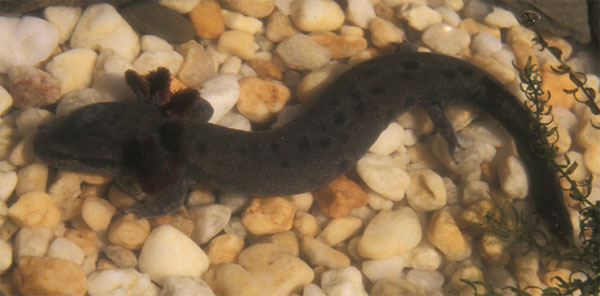 The mudpuppy is also known as a waterdog. The most striking characteristic of this salamander other than its size, or perhaps because of it, is the large feathery set of reddish gills billowing out from behind each side of the head. The legs are short but strong. The tail fin is occasionally tinted orange or red. Its small eyes have no eyelids. There are four toes on the front and hind feet. Most salamanders have five toes on the rear pair of feet. The mudpuppy, or waterdog, is gray to rusty brown on the upper surfaces, which also are showered with dark blue-black spots. The spots have irregular edges and are well-separated from one another. The pale belly is usually gray and is accented with dark spots. A dark stripe runs through each eye. Fifteen or 16 costal grooves mark each side.
The mudpuppy is also known as a waterdog. The most striking characteristic of this salamander other than its size, or perhaps because of it, is the large feathery set of reddish gills billowing out from behind each side of the head. The legs are short but strong. The tail fin is occasionally tinted orange or red. Its small eyes have no eyelids. There are four toes on the front and hind feet. Most salamanders have five toes on the rear pair of feet. The mudpuppy, or waterdog, is gray to rusty brown on the upper surfaces, which also are showered with dark blue-black spots. The spots have irregular edges and are well-separated from one another. The pale belly is usually gray and is accented with dark spots. A dark stripe runs through each eye. Fifteen or 16 costal grooves mark each side.
JEFFERSON SALAMANDER
Ambystoma jeffersonianum
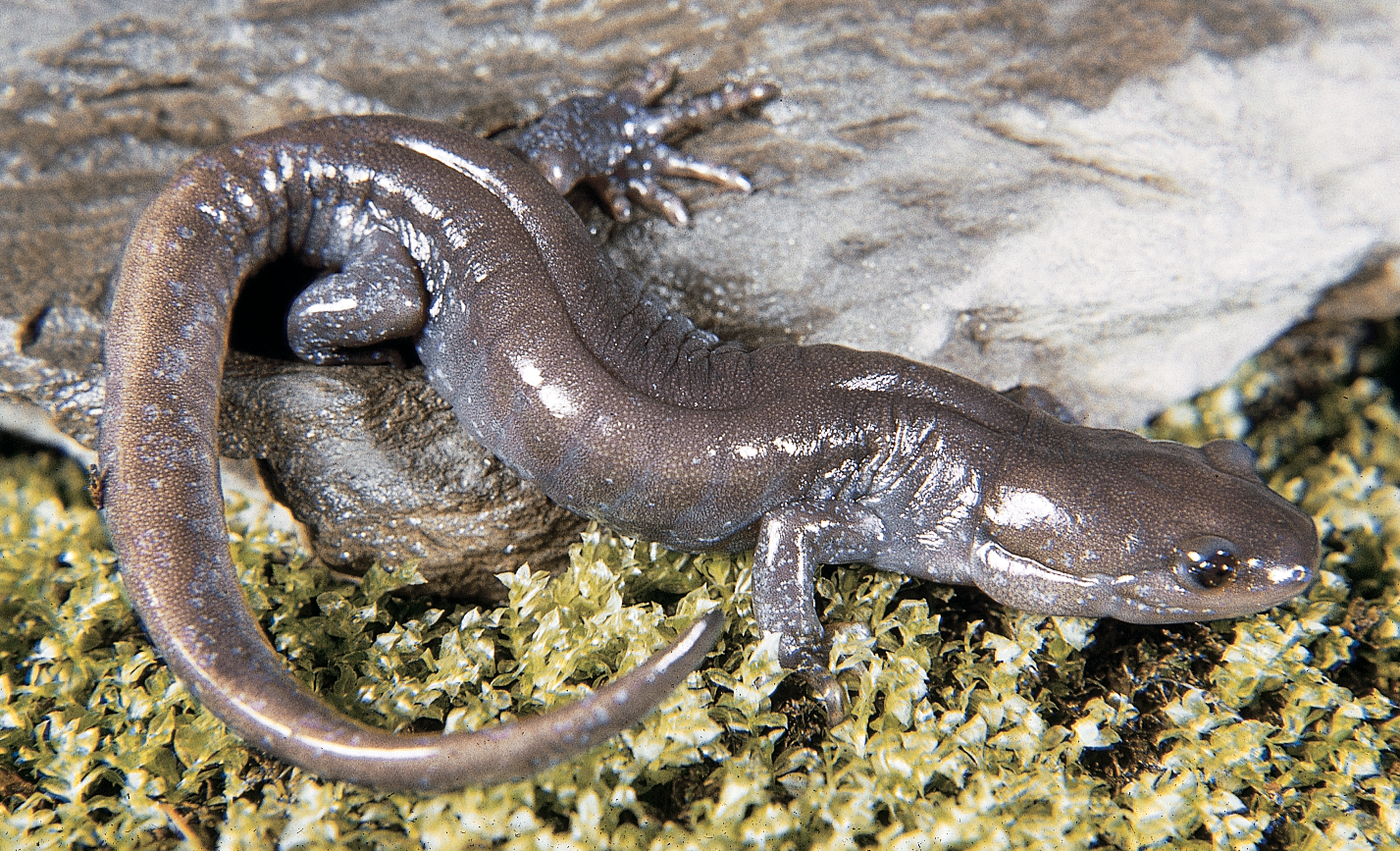 The Jefferson salamander is one of Pennsylvania's largest salamanders, attaining adult sizes that range from just over 4 inches to 7 inches. Aside from its relative, the tiger salamander, only the mudpuppy and hellbender grow to lengths longer than that.
The Jefferson salamander is one of Pennsylvania's largest salamanders, attaining adult sizes that range from just over 4 inches to 7 inches. Aside from its relative, the tiger salamander, only the mudpuppy and hellbender grow to lengths longer than that.
The Jefferson salamander is long and slender with a wide snout. Its toes are proportionately longer than those of most other salamanders. The back and sides are brownish gray; the belly is a shade lighter. The area surrounding the vent is usually gray. Small, bluish marks speckle the head, limbs and sides, but these tend to disappear with age. This salamander has 12 costal grooves on each side.
BLUE-SPOTTED SALAMANDER
Ambystoma laterale
ENDANGERED SPECIES
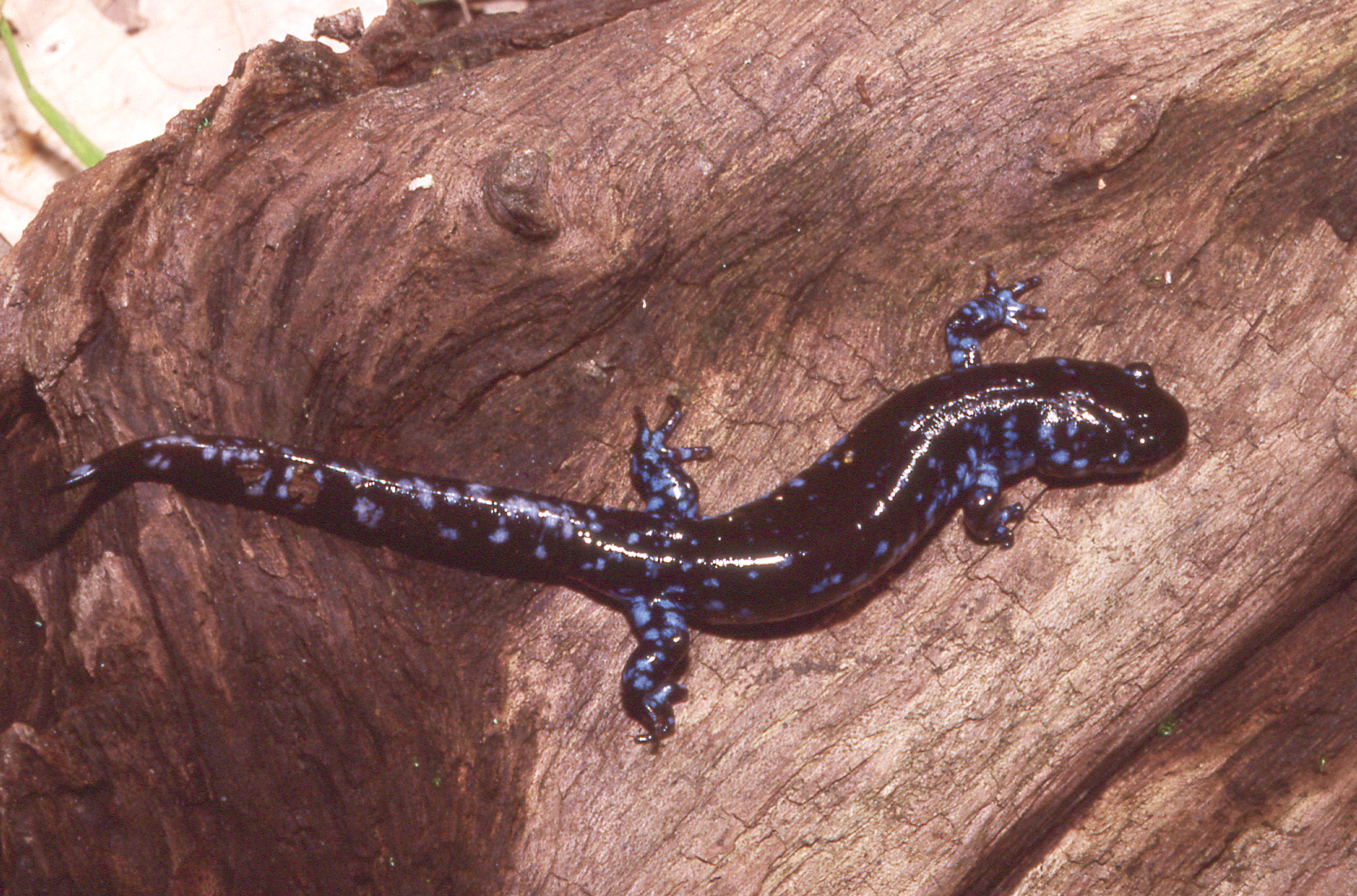 The blue-spotted salamander is closely related to the Jefferson's salamander. It is a slender salamander reaching a length of 4 to 5 1/2 inches, but nearly half of that is tail. Its namesake spots and flecks adorn its sides, legs, cheeks, tail and its back to a lesser extent. The blue-spotted salamander's spots resemble the patterns of pots and pans known as graniteware. Its belly is paler than the dark grey or ebony background color that highlights its brilliant markings.
The blue-spotted salamander is closely related to the Jefferson's salamander. It is a slender salamander reaching a length of 4 to 5 1/2 inches, but nearly half of that is tail. Its namesake spots and flecks adorn its sides, legs, cheeks, tail and its back to a lesser extent. The blue-spotted salamander's spots resemble the patterns of pots and pans known as graniteware. Its belly is paler than the dark grey or ebony background color that highlights its brilliant markings.
Although attractive, these amphibians rarely show themselves, preferring to lead a reclusive, subterranean existence. They favor moist, shady deciduous and mixed forests where they spend most of their time hunting insects, spiders and worms under leaf litter or resting in vacant, small burrows up to 3 feet below the surface.
The blue-spotted salamander was not known to occur in Pennsylvania until 2000 when it was discovered in McKean County.
SPOTTED SALAMANDER
Ambystoma maculatum
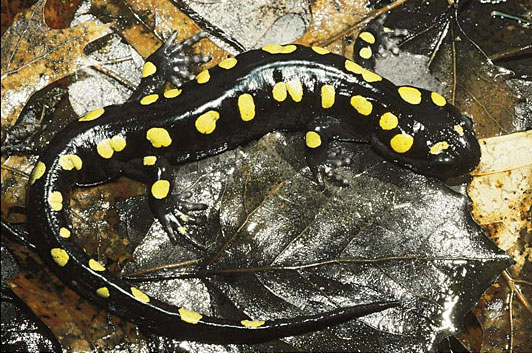 Two rows of large yellow or orange spots run erratically the length of the body. Beginning on the head and near the eyes, the spots end at the tip of the tail. The spots on the head usually are orange even though the spots on the rest of the body could be yellow. The ground color ranges from black, to blue-black, to dark gray or dark brown. The belly is slate-gray. A stout body begins with a round snout that is blunt and punctuated with large, dark eyes. There are 12 costal grooves on each side.
Two rows of large yellow or orange spots run erratically the length of the body. Beginning on the head and near the eyes, the spots end at the tip of the tail. The spots on the head usually are orange even though the spots on the rest of the body could be yellow. The ground color ranges from black, to blue-black, to dark gray or dark brown. The belly is slate-gray. A stout body begins with a round snout that is blunt and punctuated with large, dark eyes. There are 12 costal grooves on each side.
MARBLED SALAMANDER
Ambystoma opacum
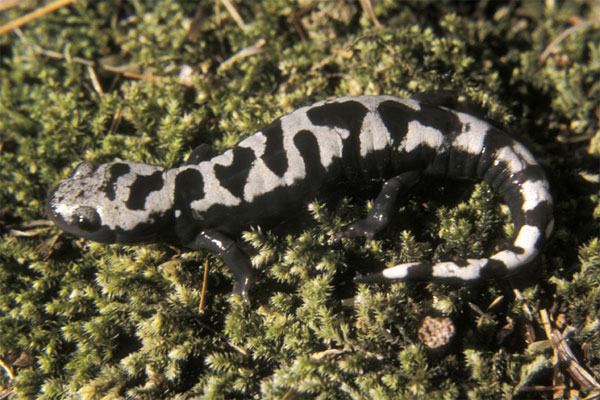 The body is dark gray to black, with bold white or silvery crossbands. On the female these bands tend to be a bit more gray. Occasionally the crossbands run together on the sides, encasing a black area within a striking outline of white. The belly is black and unmarked. The marbled salamander has 11 or 12 costal grooves on each side.
The body is dark gray to black, with bold white or silvery crossbands. On the female these bands tend to be a bit more gray. Occasionally the crossbands run together on the sides, encasing a black area within a striking outline of white. The belly is black and unmarked. The marbled salamander has 11 or 12 costal grooves on each side.
The marbled salamander adapts to a variety of habitats encompassing woodlands and low, swampy areas to relatively dry hillsides. Sandy, even gravel-laden, terrain supports the marbled salamander, which prefers a drier habitat than other members of its genus.
RED-SPOTTED NEWT
Notophthalmus viridescens viridescens
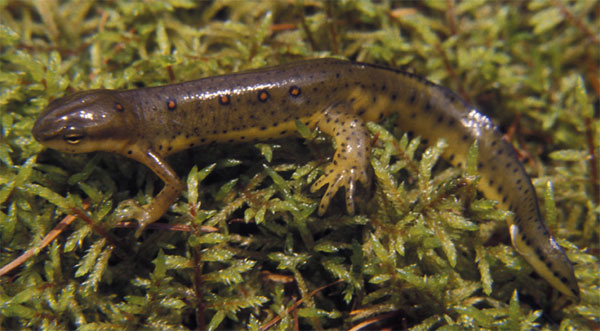 This amphibian is greenish yellow in its larval stage. It has two grayish lines, located just off center on either side of the back. The lines run the length of the body. At hatching, the larva has gills and just a hint of forelegs. Two to three months into the larval stage, the forelegs and hindlegs have been developed, the gills are lost and the skin becomes granular and textured to the touch. At this point, metamorphosis takes place. The land-dwelling red eft stage is entered and the body becomes a brilliant red to orange-red. A row of black-bordered, round red spots appears on either side of the back; the belly is yellow during this sub-adult stage.
This amphibian is greenish yellow in its larval stage. It has two grayish lines, located just off center on either side of the back. The lines run the length of the body. At hatching, the larva has gills and just a hint of forelegs. Two to three months into the larval stage, the forelegs and hindlegs have been developed, the gills are lost and the skin becomes granular and textured to the touch. At this point, metamorphosis takes place. The land-dwelling red eft stage is entered and the body becomes a brilliant red to orange-red. A row of black-bordered, round red spots appears on either side of the back; the belly is yellow during this sub-adult stage.
At the end of the eft stage and within a week of entering the water to live out its life as an adult, the skin becomes smooth, and the tail fin develops, becoming compressed vertically to look rudderlike. Its color now is drab-olive to yellowish brown or dark brown. The belly remains yellow and is sprinkled with many small black spots. A row of red spots, bordered with black, also covers the newt’s back on each side. In neither the eft nor newt stages are the costal grooves distinguishable.
GREEN SALAMANDER
Aneides aeneus
THREATENED SPECIES - SPECIES ACTION PLAN
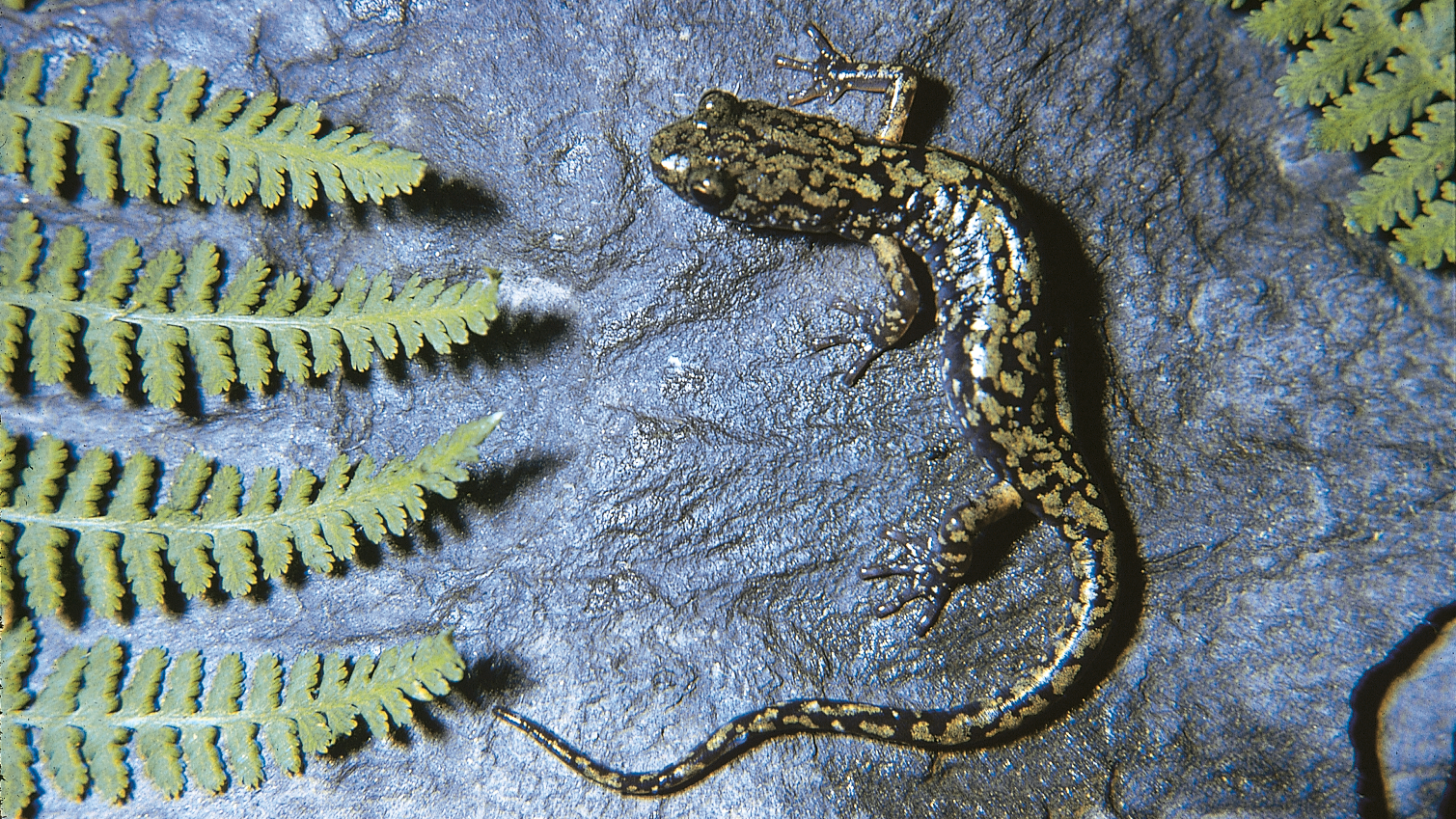 The green salamander’s green or greenish-yellow irregular patches stand out boldly against an otherwise black body. It is a slender salamander with a flattened body. The head, however, appears to be swollen in the area just behind the eyes. The toes are square-tipped and expanded. It has 14 or 15 costal grooves on each side.
The green salamander’s green or greenish-yellow irregular patches stand out boldly against an otherwise black body. It is a slender salamander with a flattened body. The head, however, appears to be swollen in the area just behind the eyes. The toes are square-tipped and expanded. It has 14 or 15 costal grooves on each side.
In Pennsylvania, the green salamander is found in only a small portion of Fayette County. Its natural range, however, extends south into Alabama, making the lower part of Pennsylvania just about the northernmost extent of its range.
NORTHERN DUSKY SALAMANDER
Desmognathus fuscus
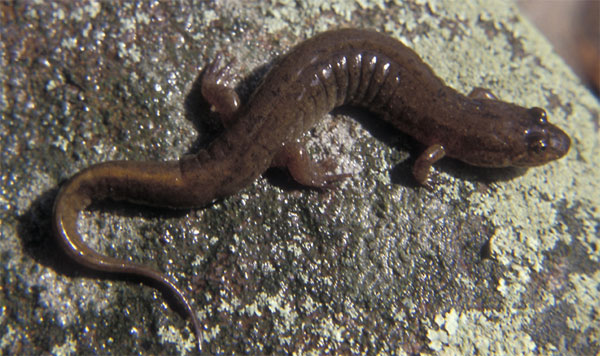 The northern dusky salamander is gray to tan or dark brown on the back becoming a bit lighter on each side. Although usually plain, a close inspection may sometimes show mottling not much darker than the background color. Larvae and juveniles have pairs of oval blotches on each side that often fuse together to form streaks running the length of the body. The underside is pinkish with blue-gray speckles. The tail is triangular and less than half the total length of the salamander. It has 14 costal grooves on each side.
The northern dusky salamander is gray to tan or dark brown on the back becoming a bit lighter on each side. Although usually plain, a close inspection may sometimes show mottling not much darker than the background color. Larvae and juveniles have pairs of oval blotches on each side that often fuse together to form streaks running the length of the body. The underside is pinkish with blue-gray speckles. The tail is triangular and less than half the total length of the salamander. It has 14 costal grooves on each side.
SEAL SALAMANDER
Desmognathus monticola
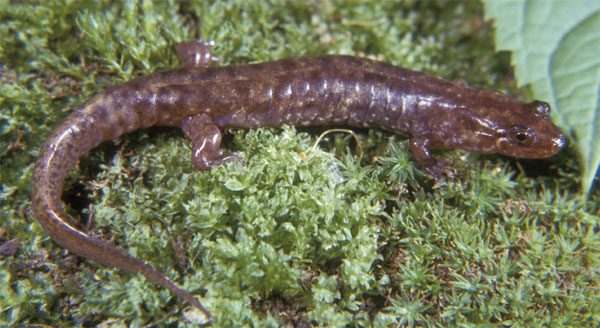 The seal salamander has a robust body similar to its cousin, the northern dusky salamander. The tail makes up about half the total length of this salamander. The tail is compressed, and the tip is knife-edged on the upper side. The very tip of the tail is pointed. Although the body can be variably patterned, it is mainly light brown or grayish above with dark brown or black wavy streaks or reticulations that stand out markedly. Sometimes these markings take on the appearance of wormlike blotches and may be surrounded by paler areas. The belly is light and usually plain, although specimens may be found with blotches on the underside. The sides are dark above but lighter and speckled as they approach the belly line. There are 14 costal grooves on each side.
The seal salamander has a robust body similar to its cousin, the northern dusky salamander. The tail makes up about half the total length of this salamander. The tail is compressed, and the tip is knife-edged on the upper side. The very tip of the tail is pointed. Although the body can be variably patterned, it is mainly light brown or grayish above with dark brown or black wavy streaks or reticulations that stand out markedly. Sometimes these markings take on the appearance of wormlike blotches and may be surrounded by paler areas. The belly is light and usually plain, although specimens may be found with blotches on the underside. The sides are dark above but lighter and speckled as they approach the belly line. There are 14 costal grooves on each side.
ALLEGHENY MOUNTAIN DUSKY SALAMANDER
Desmognathus ochrophaeus
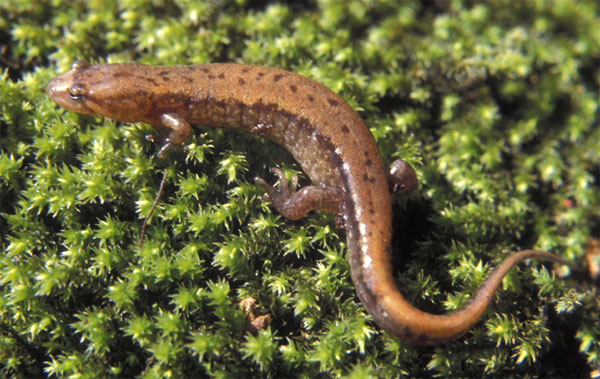 The ground color, covering the sides and part of the back, is usually a dark color and can be almost anything ranging from gray to brown, olive to dark-yellow, and even darkish orange. A lighter stripe, bordered with a very dark, sometimes black pigment, runs the length of the body and onto the tail. This stripe can also be a variety of colors including orange, yellow, gray, tan or red. The stripe is wide, straight-edged and accented with dark vee-shaped marks. The face is marked with a light line extending from the eye to the jaw. The tail is slender and rounded. Each side has 14 costal grooves.
The ground color, covering the sides and part of the back, is usually a dark color and can be almost anything ranging from gray to brown, olive to dark-yellow, and even darkish orange. A lighter stripe, bordered with a very dark, sometimes black pigment, runs the length of the body and onto the tail. This stripe can also be a variety of colors including orange, yellow, gray, tan or red. The stripe is wide, straight-edged and accented with dark vee-shaped marks. The face is marked with a light line extending from the eye to the jaw. The tail is slender and rounded. Each side has 14 costal grooves.
NORTHERN TWO-LINED SALAMANDER
Eurycea bislineata
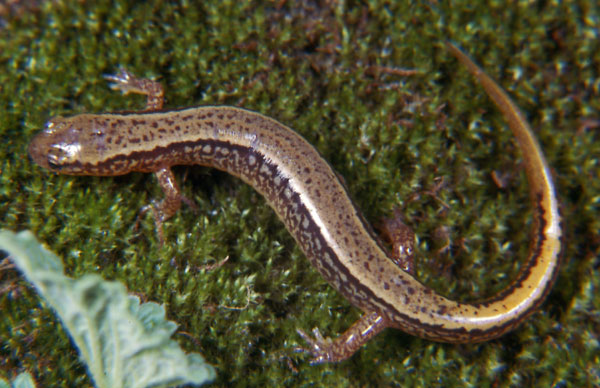 The primary color of this salamander is yellow, although it may be tinged with brown, green or orange-bronze. The back is nearly covered with a lighter stripe that runs the length of the body. This broad stripe is bordered with narrower black or dark-brown stripes that begin at the eyes and end on the tail where occasionally they break up into small spots. The belly is bright-yellow. There are 13 to 16 costal grooves on each side.
The primary color of this salamander is yellow, although it may be tinged with brown, green or orange-bronze. The back is nearly covered with a lighter stripe that runs the length of the body. This broad stripe is bordered with narrower black or dark-brown stripes that begin at the eyes and end on the tail where occasionally they break up into small spots. The belly is bright-yellow. There are 13 to 16 costal grooves on each side.
EASTERN LONG-TAILED SALAMANDER
Eurycea longicauda longicauda
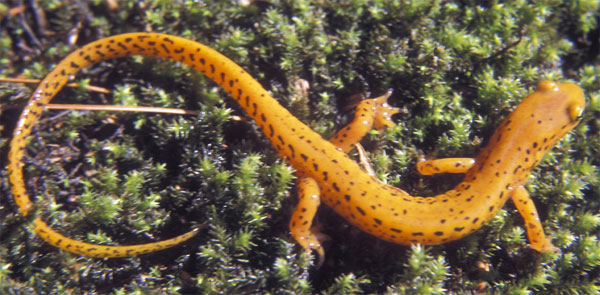 Much longer than the body, the tail is slender but continues the color and pattern that begin on the head. This salamander is yellow to bright red-orange and is marked with contrasting black spots. The spots are heavier on the sides than they are across the back, and on the tail the spots may combine to form vertical bars. There are 13 or 14 costal grooves on each side.
Much longer than the body, the tail is slender but continues the color and pattern that begin on the head. This salamander is yellow to bright red-orange and is marked with contrasting black spots. The spots are heavier on the sides than they are across the back, and on the tail the spots may combine to form vertical bars. There are 13 or 14 costal grooves on each side.
NORTHERN SPRING SALAMANDER
Gyrinophilus porphyriticus porphyriticus
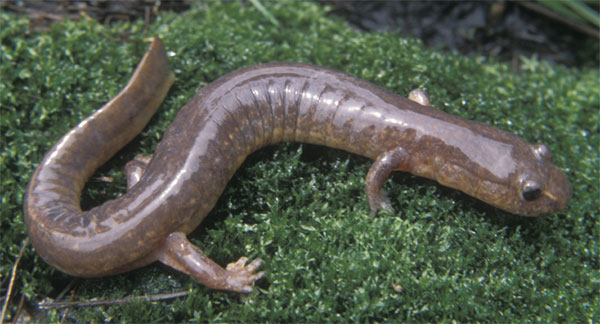 The basic color is salmon, although variations occur through tints of reddish brown, yellowish brown or light orange. The back and sides sometimes have markings, and even then they are often nearly obscured, appearing as a very subdued mottling. The belly is lighter. A light line edged with black begins at the eye and extends downward to the nostril. Each side has 17 to 19 costal grooves.
The basic color is salmon, although variations occur through tints of reddish brown, yellowish brown or light orange. The back and sides sometimes have markings, and even then they are often nearly obscured, appearing as a very subdued mottling. The belly is lighter. A light line edged with black begins at the eye and extends downward to the nostril. Each side has 17 to 19 costal grooves.
FOUR-TOED SALAMANDER
Hemidactylium scutatum
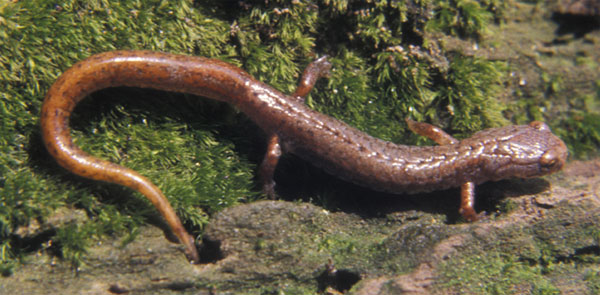 Only four toes appear on each hind foot (most other salamanders have five toes). The belly is marked with large, bold black spots that stand out against an almost pure white. The back of the four-toed salamander is reddish brown to yellowish tan. Its sides tend to be gray. The thick tail is marked near its base with a constrictive ring, indicating the point at which it would separate. Each side has 12 to 14 costal grooves.
Only four toes appear on each hind foot (most other salamanders have five toes). The belly is marked with large, bold black spots that stand out against an almost pure white. The back of the four-toed salamander is reddish brown to yellowish tan. Its sides tend to be gray. The thick tail is marked near its base with a constrictive ring, indicating the point at which it would separate. Each side has 12 to 14 costal grooves.
EASTERN RED-BACKED SALAMANDER
Plethodon cinereus
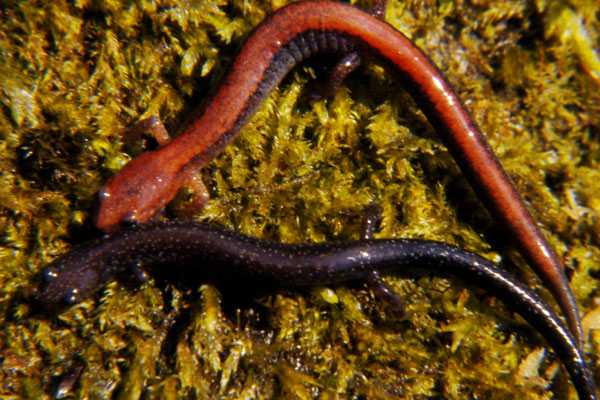 This lungless salamander is also known in a different phase as the leadback salamander. It is long and slender. The redback is marked with a broad stripe that begins at the head and flows down the back and over the upper part of the tail, where the stripe shrinks in width. The stripe is usually red, although it sometimes may appear orange, yellow, pink or light gray. The sides are black, and this color extends upward to form a straight-edged border on each side of the stripe. The leadback color phase ranges from a light gray to almost black. The solid color is shaded uniformly and does not have the colorful stripe along the back. A third color phase is found only occasionally. Marked with an unusual redness, it is referred to as an erythristic phase. The entire body, except for the belly, is red. Regardless of the color phase the belly is always mottled in a distinctive pattern of black and white. Each side has 18 to 20 costal grooves.
This lungless salamander is also known in a different phase as the leadback salamander. It is long and slender. The redback is marked with a broad stripe that begins at the head and flows down the back and over the upper part of the tail, where the stripe shrinks in width. The stripe is usually red, although it sometimes may appear orange, yellow, pink or light gray. The sides are black, and this color extends upward to form a straight-edged border on each side of the stripe. The leadback color phase ranges from a light gray to almost black. The solid color is shaded uniformly and does not have the colorful stripe along the back. A third color phase is found only occasionally. Marked with an unusual redness, it is referred to as an erythristic phase. The entire body, except for the belly, is red. Regardless of the color phase the belly is always mottled in a distinctive pattern of black and white. Each side has 18 to 20 costal grooves.
NORTHERN SLIMY SALAMANDER
Plethodon glutinosus
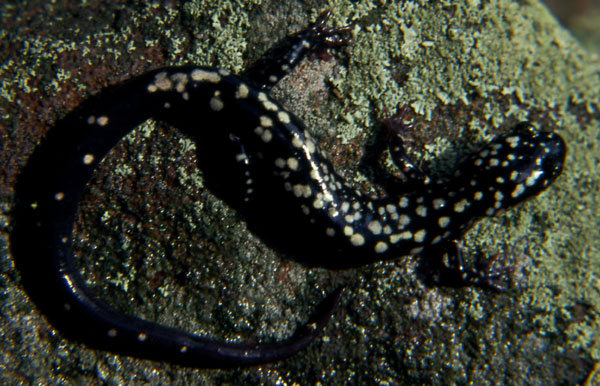 The slimy salamander is a medium-sized creature of the forest and considered one of the woodland salamanders. Adult sizes range from barely 5 to nearly 7 inches. This amphibian has skin glands that secrete a thick, gluey substance. The slimy salamander wanders about mostly at night, spending its day in hiding.
The slimy salamander is a medium-sized creature of the forest and considered one of the woodland salamanders. Adult sizes range from barely 5 to nearly 7 inches. This amphibian has skin glands that secrete a thick, gluey substance. The slimy salamander wanders about mostly at night, spending its day in hiding.
The slimy salamander is black, with a shiny coat that is marked with whitish or silver-colored spots. The spots are larger on the sides, but smaller and scattered over the back and tail. The belly is slate-colored and unmarked. The chin and throat areas are dark gray. Each side has 16 costal grooves.
VALLEY AND RIDGE SALAMANDER
Plethodon hoffmani
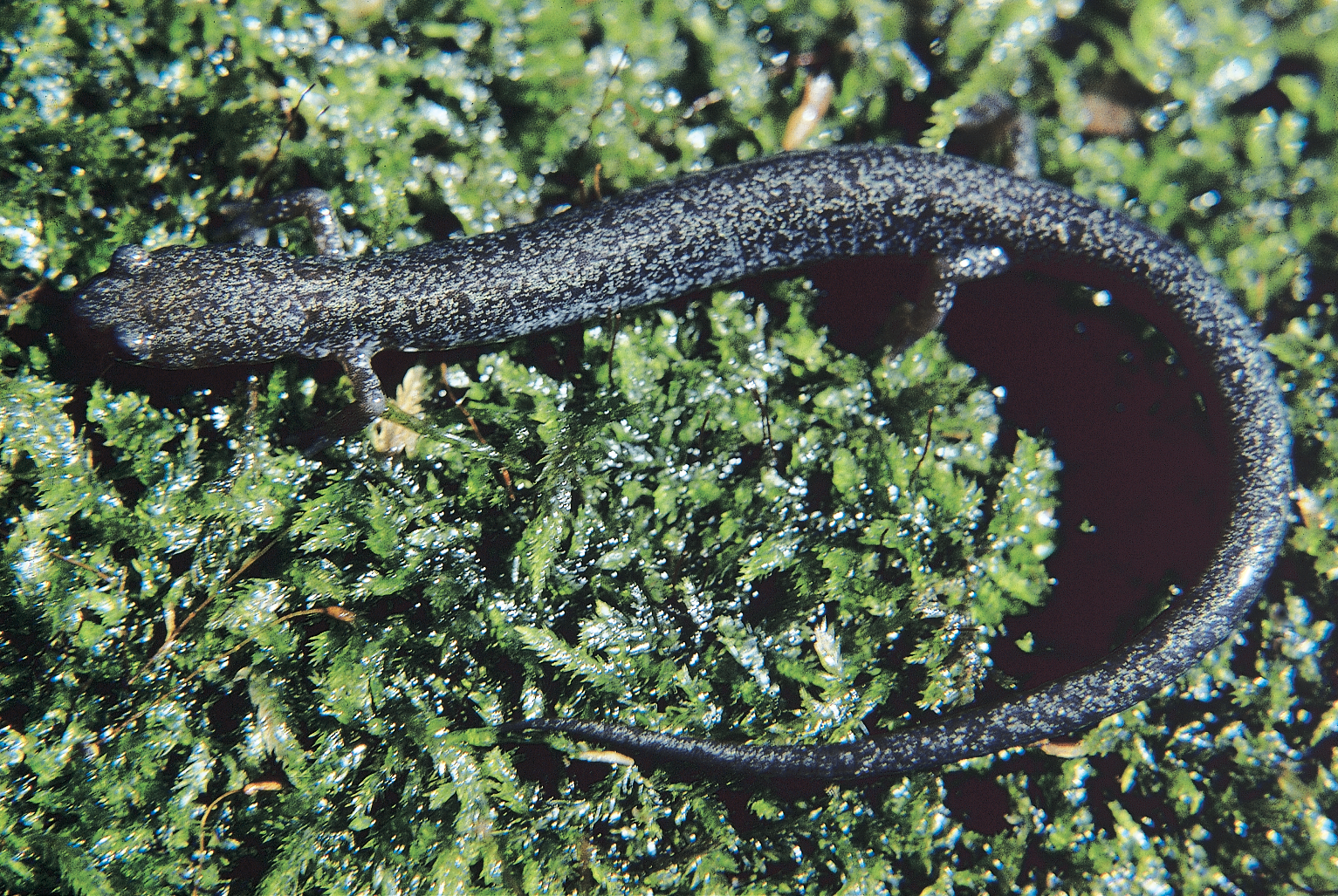 Found in southcentral Pennsylvania, the valley and ridge salamander's range is in the mountains east of the Allegheny Mountains portion of the Susquehanna River Valley, extending south and west to the New River in Virginia. It prefers well-drained soils. It is nocturnal and most active in the spring and fall.
Found in southcentral Pennsylvania, the valley and ridge salamander's range is in the mountains east of the Allegheny Mountains portion of the Susquehanna River Valley, extending south and west to the New River in Virginia. It prefers well-drained soils. It is nocturnal and most active in the spring and fall.
The valley and ridge salamander is a small, slender salamander from about three to five inches in length. Its back is dark brown, speckled with tiny flecks of silver white or bronze; the belly is dark with white markings. There are 21 costal grooves. Breeding occurs in May or June when three to eight eggs are laid. The eggs hatch in late summer or early fall.
WEHRLE'S SALAMANDER
Plethodon wehrlei
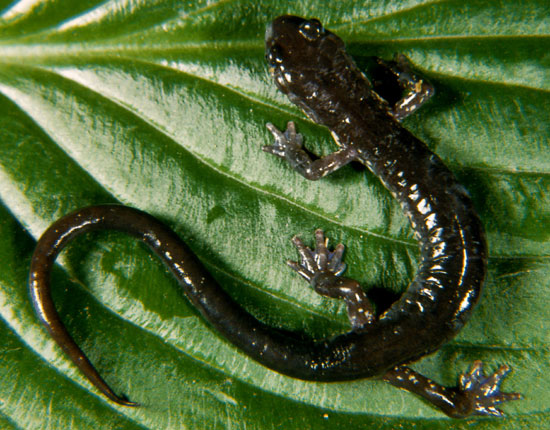 The Wehrle's salamander ranges in length from 4 to just over 5 inches as an adult. The body is bluish gray to dark-brown or almost black. Irregular spots, often looking more like dash marks, appear on the sides. They are white or bluish white in most cases, but sometimes can appear yellow. The back occasionally is marked with very small flecks of a lighter color. The belly and the underside of the tail are evenly tinted in gray. The throat is white or at least blotched with white. There are about 17 costal grooves on each side.
The Wehrle's salamander ranges in length from 4 to just over 5 inches as an adult. The body is bluish gray to dark-brown or almost black. Irregular spots, often looking more like dash marks, appear on the sides. They are white or bluish white in most cases, but sometimes can appear yellow. The back occasionally is marked with very small flecks of a lighter color. The belly and the underside of the tail are evenly tinted in gray. The throat is white or at least blotched with white. There are about 17 costal grooves on each side.
In Pennsylvania, the Wehrle's salamander inhabits an area that generally includes the Allegheny Mountains as they range from the southwestern corner of the state to the northcentral.
NORTHERN RAVINE SALAMANDER
Plethodon electromorphus
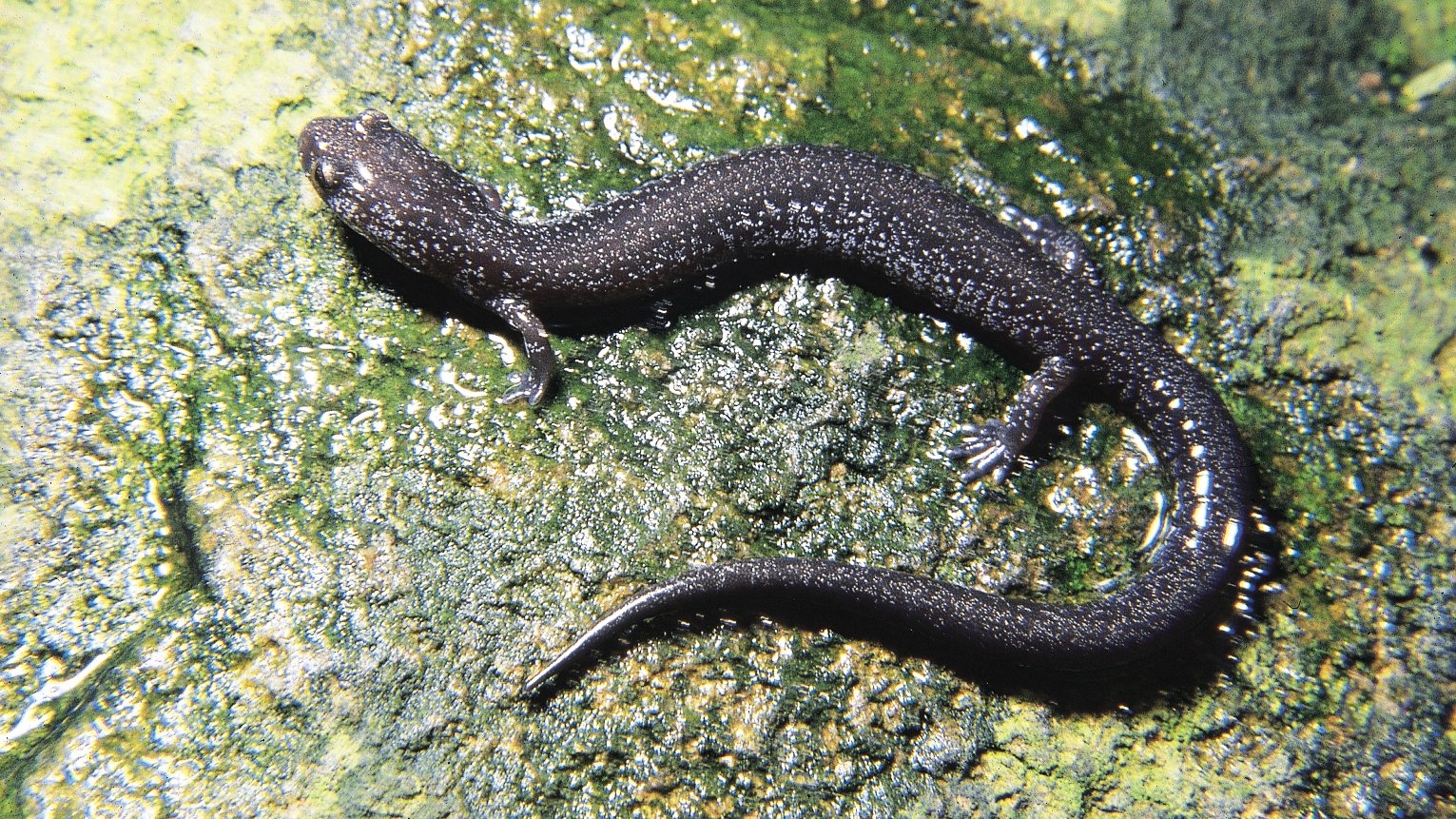 This lungless salamander inhabits several counties in the western and southwestern portion of the state. Wooded ravines and tree-covered hillsides as they slope to the valleys are favorite habitats. The ravine salamander never enters water, but forages throughout its forest home. It is more active during the cooler months of spring and fall than it is during the summer months.
This lungless salamander inhabits several counties in the western and southwestern portion of the state. Wooded ravines and tree-covered hillsides as they slope to the valleys are favorite habitats. The ravine salamander never enters water, but forages throughout its forest home. It is more active during the cooler months of spring and fall than it is during the summer months.
This salamander is 3 to 4 1/2 inches long as an adult. It is slender and has short legs; the head is narrow. Small white or yellow blotches mark the lower sides, and very small brass or silvery irregular dots accent a brown to blackish back. Costal grooves vary in number from 19 to 22. The ravine salamander lays its eggs in a cavity beneath the ground. Usually about six eggs are deposited in the spring, and they incubate until late summer before they hatch. There is no aquatic larval stage.
EASTERN MUD SALAMANDER
Pseudotriton montanus montanus
ENDANGERED SPECIES
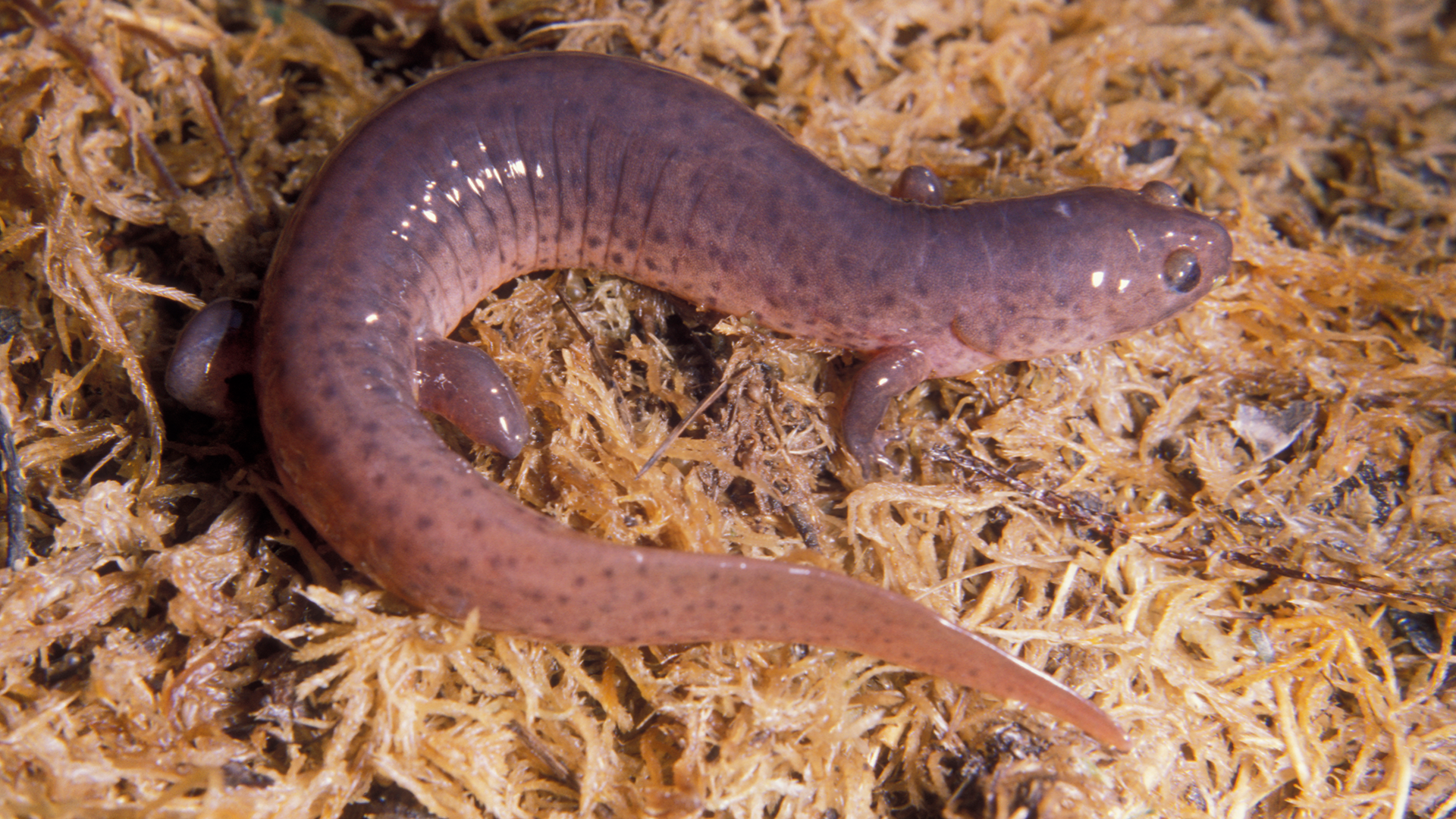 This is a salamander of muddy springs and swamplands. It also likes the muddy areas commonly found around springs and seeps and finds refuge buried in the muck. It inhabits only a small portion of extreme southcentral Pennsylvania and its range then jumps to states east and south of Pennsylvania.
This is a salamander of muddy springs and swamplands. It also likes the muddy areas commonly found around springs and seeps and finds refuge buried in the muck. It inhabits only a small portion of extreme southcentral Pennsylvania and its range then jumps to states east and south of Pennsylvania.
Reaching adult sizes of three to seven inches, the eastern mud salamander has a short tail and short legs. Its general coloration is bright red, pinkish or salmon and it has scattered black spots on the back, sides and belly. The belly is reddish or yellowish and lighter than the colors on the back and sides. The costal grooves number 16 or 17. The female lays 75 to nearly 200 eggs in late fall or early winter. The larvae hatch during late winter and transform in one to three years.
NORTHERN RED SALAMANDER
Pseudotriton ruber ruber
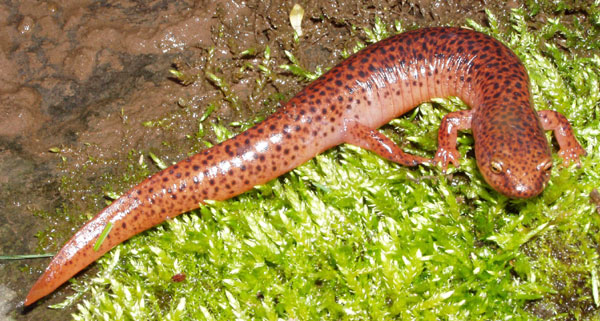 Red is the primary body color. Even so, variations occur and it can be reddish brown to orange-brown. The adults tend to be darker than the young. The sides shade toward a lighter tone as they approach an even lighter belly. The back and the upper portion of the sides are dotted with many and irregularly shaped jet-black spots. Small dark spots may appear on the belly. Sixteen to 17 costal grooves mark each side.
Red is the primary body color. Even so, variations occur and it can be reddish brown to orange-brown. The adults tend to be darker than the young. The sides shade toward a lighter tone as they approach an even lighter belly. The back and the upper portion of the sides are dotted with many and irregularly shaped jet-black spots. Small dark spots may appear on the belly. Sixteen to 17 costal grooves mark each side.